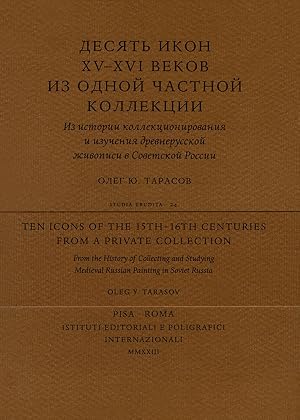About this Item
Istituti editoriali e poligrafici internazionali, 2023, pp. 228 con 36 figure in bianco/nero n.t. e 10 tavole in bianco/nero e a colori f.t. NUOVO -- The book offers a new, historical and cultural reading of the personal collection of Post-Byzantine and medieval Russian paintings. The discovery, study and collection of medieval icons and early Italian painting, of course, developed along parallel paths in Western Europe and in Russia. In the nineteenth century this was the preserve mainly of amateur archaeologists, and in the next century it was taken up by professional experts (connoisseurs). This volume therefore engages not only with the writings and personal art collections of Bernard Berenson (1865-1959), Roberto Longhi (1890-1970) or Federico Zeri (1921-1998), but also with the typologically similar works and art collections of Pavel Muratov (1881-1950) and Alexander Anisimov (1887-1937), as well as with the private collections of Soviet and modern art historians, many of whom worked as art critics and expert consultants. Many of them had their own small collections of icons and paintings. The author s private collection of Post-Byzantine and medieval Russian icons, which underpins this volume, also belongs to this type of collection. Each of the ten icons from the fifteenth and sixteenth centuries reproduced in this book came from a famous collection and is closely connected with the history of the study and collecting of medieval Russian painting in Soviet Russia. Hence the iconography and symbolism of the artistic language of these icons are explored within the broad context of the development of their study and collection, and of the art market. Thus, the Novgorodian Transfiguration icon, dating from the first half of the sixteenth century, comes from the former collection of one of the founders of Russian art nouveau, the architect Alexey Shchusev (1873-1949), and invites the reader to consider the aesthetic reassessment of medieval icons in the early twentieth century. The problem of attribution of the works of Dionysius (1444-1502) and the masters of his circle is highlighted by an analysis of the artistic features of the Moscow icon Mother of God Hodegetria , dating from the end of the fifteenth century. The Post-Byzantine Greek icon Theotokos Hodegetria , from the last quarter of the fifteenth century, allows us to trace not only the spread of late Paleologian icons in the artistic environments of Athos and Moscow, but also highlights the peculiarities of collecting medieval icons in Soviet Russia after World War II, for example. The book devotes particular attention to the theory of reverse perspective by Pavel Florensky (1882-1937), as well as to the analysis of the artistic language of icons that is grounded in it. A wealth of historical and cultural research on the collection presented in this book is complemented by the first publication of a lithograph by Marc Chagall (1887-1985), given by the artist to the Moscow collector of icons and Russian avant-garde art George Kostakis (1919-1990) in 1973. Executed by the hand of the artist himself and containing a dedication, this lithograph, as shown, has a special meaning, since it returns the reader to the very beginnings of research on the theme of the icon and the avant-garde , which today is attracting increasing attention. The last chapter of the book is devoted to theoretical reflection on the phenomenon of collecting medieval icons. It concludes that a collector s living engagement with ancient icons constantly refreshes their emotional and creative perception of the most diverse cultural phenomena. Turning to the philosophy of the sign and the ontology of existence, noting the multiplicity of points of view in the construction of the medieval image s artistic space, the collector is continuously reminded that medieval icons may pose the most important existential questions. Seller Inventory # ca1149
Contact seller
Report this item
![]()
